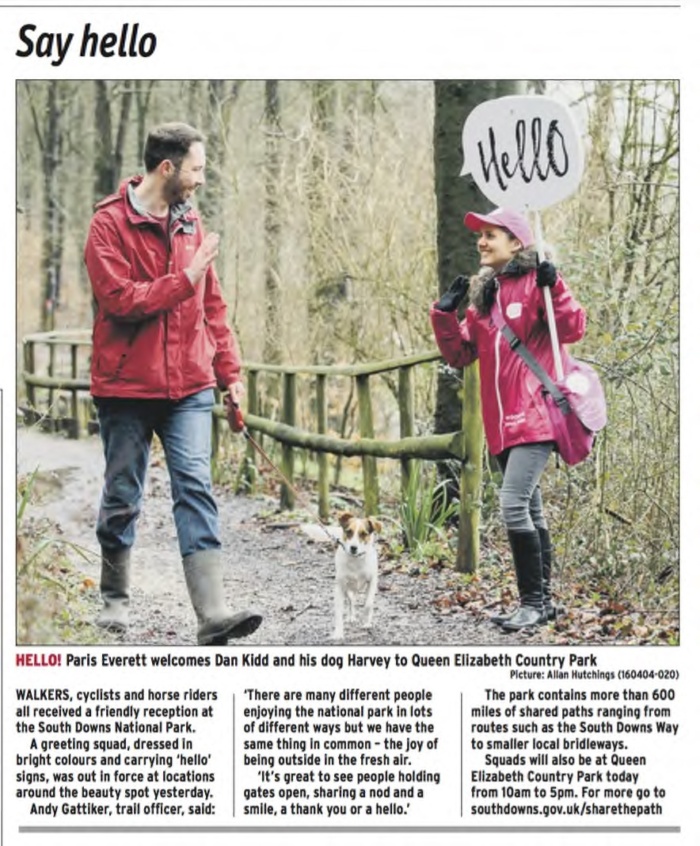Background
The South Downs National Park includes more than 1,000km of shared paths, which are enjoyed by a wide range of different types of user. Conflict between them is rare but misunderstandings can lead to stereotyping and bad feeling. We worked with the Park Authority to engage path users, reinforcing and spreading a positive norm of behaviour: a simple “hello” as they pass.
Impact
The South Downs is the UK’s newest National Park. The shared paths in the Park are enjoyed every day by increasing numbers of ramblers, hikers, dog walkers, cyclists, horse riders, land owners and farmers. Whilst incidents of conflict or actual collisions between these groups are very rare, misunderstanding and mild antipathy can occur, leading to stereotyping, apprehension and a negative experience for some users.
Existing research told us:
- It's important not to focus on conflict as doing so increases perception that it’s a problem
- Singling out individual user groups can create resentment by giving the impression that they’re solely to blame
- Some path users need a better understanding of rights and responsibilities, but messages need to be simple and succinct and the risk with a ‘code of practice’ is that people may read it once and forget it
Our job was to help people share the path by:
- Not trying to change the ‘silent annoyance’ in people’s minds
- Focusing on encouraging a positive behaviour instead
- Making sure it’s something all user groups can do
Intervention
The good news was that a positive behaviour already existed, which is the norm for the vast majority of path users: simply interacting as you pass.
"Hello" "Excuse me" "Thank you"

So our intervention centred around how we could encourage these positive interactions:
- Engage path users to reinforce and spread this positive social norm of behaviour
- 'Prime' people by reminding them that it is the normal thing to do
- Assume everyone already does this (and help new users to adopt it)
- Find appropriate and engaging moments to do so
- Work with partners and the media to spread the word
Implementation
We built activity around a simple expression of the social norm we were encouraging.
Around this we developed a set of creative assets to support activity focused during the Easter holidays, which aimed to reach people in the right place at the right time with our message.
- Street teams out on the South Downs Way over the Easter weekend embodied the idea by greeting all path users enthusiastically and handing out postcards which brought to life our messaging
- Local PR to spread the word about the new campaign, using the street team activity as a focal point
- Creation of a short film “George & Dean: Britain’s Friendliest Walkers” which was delivered by Minds Eye Productions at a tenth of the usual budget for a production of similar scale and quality
- Social media activity on Twitter and Facebook spreading positive tales of #sharethepath
- Stakeholder engagement with larger national organisations and local businesses and clubs

Impact
The campaign was much loved internally at the SDNPA and widely engaged with outside of it. On a small budget, we delivered:
- Over 36,000 views of George & Dean on YouTube
- Street teams handing out 5,700 postcards and engaging many more people on the path
- 14 pieces of local media coverage including one TV and two radio pieces
- 10 pieces of national media coverage after the campaign took on a life of its own, including brief mentions on BBC Radio 5 Live, BBC Radio 4 Today and BBC Breakfast, with a longer debate on Sky News (where the film was shown throughout the piece), plus Times, Guardian, Mail, Telegraph
- A reach of 41,000 from tweets/retweets
- 10,000 postcards distributed by local businesses and messaging materials shared with over 75 local organisations, clubs, bike hire shops etc.
"Well that stopped me, a campaign to encourage politeness, what a brilliant idea. That's put a little smile on my face."

